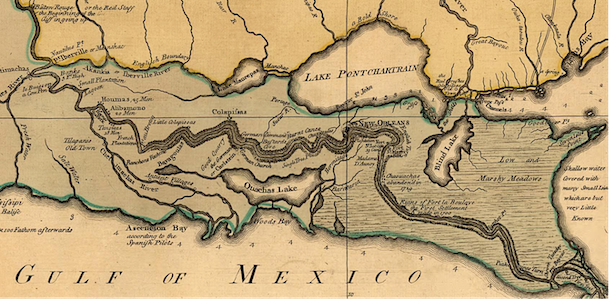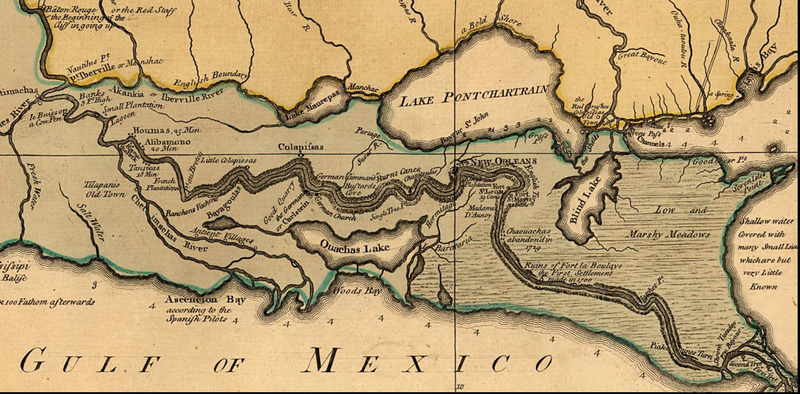A Woman Flees to the Woods of the Petits Collas Story Info
- Title:
- A Woman Flees to the Woods of the Petits Collas
- Date:
- 1725-04-10
- Story:
-
In this document, we meet an enslaved woman who had been forced upriver from New Orleans to a plantation near the village of the Petits Collas (Acolapissa) south of present-day Baton Rouge. Amidst a financial feud between slave-traders, she made a courageous escape. Though these enslavers neglected to even record her name, she refused to be contained.
Since their arrival in Louisiana, the French relied on the peoples and polities they called les Petites Nations. These smaller, often multinational Indigenous nations shaped the course of French colonization in the Lower Mississippi Valley.1 By December of 1722, this woman’s enslaver, de Chavannes, moved his plantation to the land of the Petits Collas, a smaller band of the Acolapissas. According to colonial accounts, the village of the Petits Collas was located approximately three leagues from the larger Acolapissa settlement.2 During the same year that her experiences were recorded by the French Superior Council, governor Jean-Baptiste Le Moyne de Bienville reported that the Acolapissas “furnish us almost all the fresh meat that is consumed at New Orleans.”3 Relying on the skills and resources of the Petites Nations, the New Orleans community depended on the administration’s diplomacy–or their military strength–to survive.
Filtered through the words and perspective of her enslaver, we learn of her pain and of her marronage, her enslaver trying to shift blame off of himself for her disappearance. Attributing her decision to flee–first into the Mississippi River and later into the woods–to “losing her mind,” de Chavannes recounts her escape while attacking her mental acuity and intelligence. Madness, he reasoned, without a cause. He described how he forced this woman upriver from New Orleans in a pirogue. According to him, when they arrived at the Acolapissa settlement, she became visibly distraught. He continued upriver anyway, later referring to her distress dismissively as “folies et frenesies,” language that foreshadows slaveholders’ creation of the social, legal, and medical category of enslaved people’s “soundness” in the nineteenth-century.4 When they arrived at de Chavannes’ plantation the next morning near the village of the Petits Collas, this woman appeared distressed again. Upon seeing several Native rowers in a pirogue, she jumped into the Mississippi River. Chavannes contends this was an attempt to end her life, rather than her desire to flee towards them. After being forced to shore, and forced to eat and drink, the woman waited for her opportunity. She ran to the surrounding woods and never returned.
Her decision to flee from enslavement into the woods of the Petits Collas foregrounds the power of Afro-Indigenous solidarity in French-controlled Louisiana. Administrators policed African and Native collaboration, fearing the possibilities of their solidarity and the reality of shared maroon settlements, kinship networks, and even familial relationships. A few years after her enslaver had documented her experience through his dispute over payment, Governor Étienne de Perrier and commissaire-ordonnateur Jacques DeLaChaise tried to deputize Native nations from New Orleans to Natchez to hunt runaway slaves, both Black and Indigenous, and offered 160 livres worth of goods for their capture.5 While some nations indeed participated, others rose up and took arms against the French. After the Natchez Uprising of 1729, officials hoped to sever connections and kinship between African and Indigenous peoples and used violence to deter enslaved people like the woman in this story from retreating to the safety of Native nations, maroon communities, and elsewhere.
Further Resources

Fig. 1. Map depicting the course of the Mississippi River between New Orleans and Baton Rouge, with the location of the village of the Petits Collas. Source: Detail of Robert Sayer, Course of the river Mississippi, from the Balise to Fort Chartres; taken on an expedition to the Illinois, in the latter end of the year 1765, map, 1772, Library of Congress, control # 74696221.Notes
-
Elizabeth N. Ellis, The Great Power of Small Nations: Indigenous Diplomacy in the Gulf South (Philadelphia: University of Pennsylvania Press, 2022). See also, Leila K. Blackbird, “‘It Has Always Been Customary to Make Slaves of Savages’: The Problem of Indian Slavery in Spanish Louisiana Revisited, 1769-1803,” The William & Mary Quarterly 80, no. 3 (July 2023): 525–558. ↩
-
Prior to de Chavannes, the concession belonged to Paul-François de Béthune Charost, the Marquis d’Ancenis, who abandoned the land after a fire and other incidents destroyed the place. Pierre-François-Xavier de Charlevoix and Micah True, The Jesuit Pierre-François-Xavier de Charlevoix’s (1682-1761) journal of a voyage in North America: an annotated translation (Leiden, Boston: Brill, 2019), 448; “Journal of Diron D’Artaguiette, Inspector General of Louisiana, 1722-1723,” in Newton D. Mereness, ed., Travels in the American Colonies (New York: Macmillan Company, 1916), 41-42, https://www.loc.gov/item/16009410/. ↩
-
Bienville’s memoir of Louisiana 1725-1726, Mississippi Provincial Archives: 1704-1743, French Dominion, vol. 3 ed. Dunbar Rowland and Albert Godfrey Sanders, trans. Dunbar Rowland (Jackson, MS: Press of the Mississippi Department of Archives and History, 1924), 3:535; Ellis, Great Power, 124. ↩
-
Jenifer L. Barclay, The Mark of Slavery: Disability, Race, and Gender in Antebellum America (Urbana: University of Illinois Press, 2021). ↩
-
Gwendolyn Midlo Hall, Africans in Colonial Louisiana: The Development of Afro-Creole Culture in the Eighteenth Century (Baton Rouge: Louisiana State University Press, 1992), 98-99. ↩
-
- Keywords:
- collaboration debt fugitivity Indigenous peoples marronage transportation wellness
- Latitude:
- 30.022
- Longitude:
- -90.748
- Documents:
- d0188

